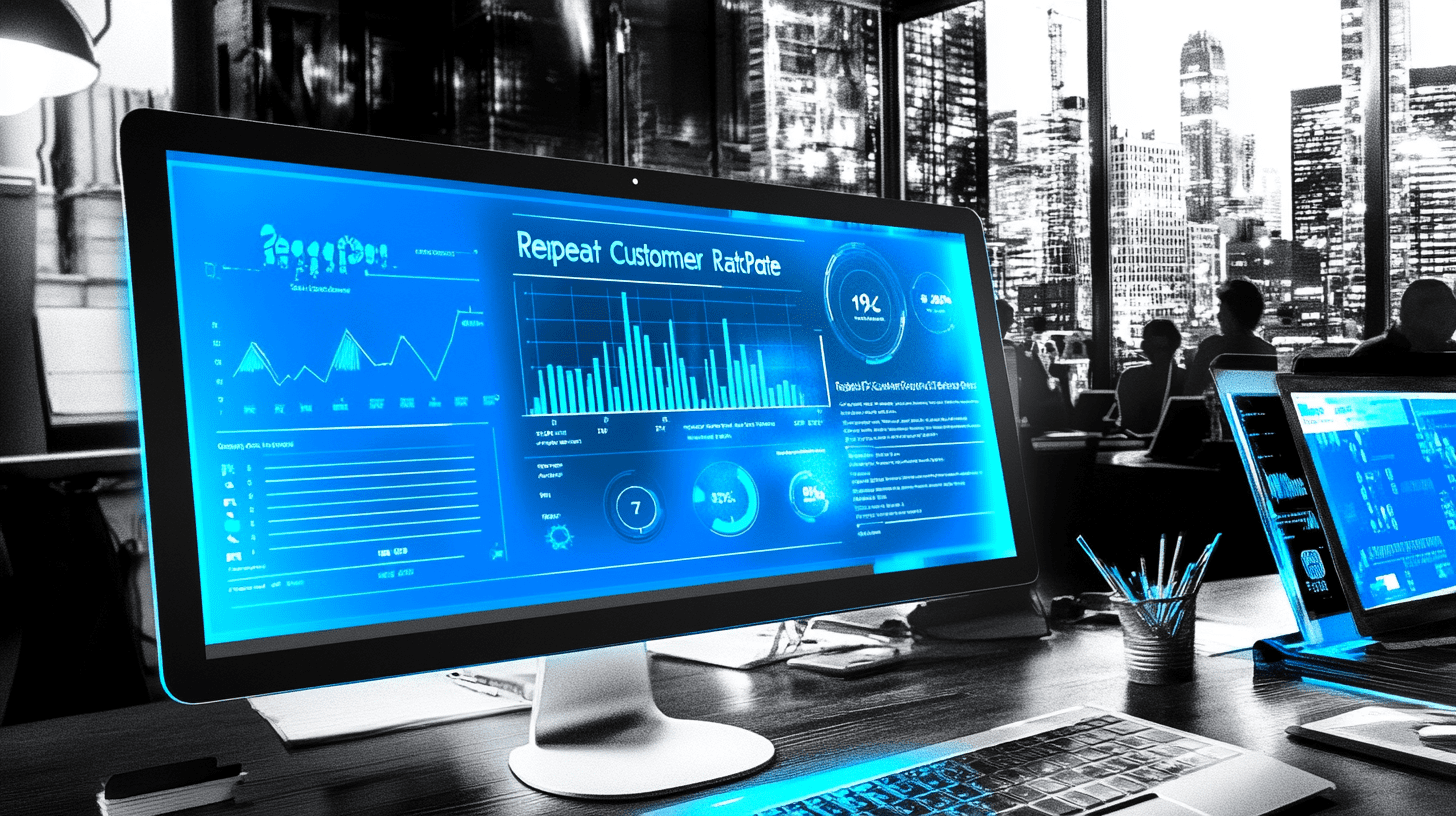Is your business tracking the right metrics for growth? Or are you focusing on numbers that don’t lead to real success? Key point indicators are like a compass for success. They guide you, but only if you choose them wisely.
These indicators show your business’s health, like a heartbeat. Without them, you’re making decisions without seeing the full picture. Data is key in today’s world.
Metrics like customer lifetime value (CLV) and customer acquisition cost (CAC) help you improve. But many leaders find it hard to pick the right KPIs. Did you know effective teams focus on fewer than 25 KPIs? These align with the Balanced Scorecard’s four pillars: financial, customer, process, and people.
This guide will show you how to turn data into useful insights. Whether you’re a tech startup or a retail chain, KPIs guide you. But how do you not get lost in too many metrics?
We’ll make it simple. Imagine every business metric was as easy to understand as a calculator. Simple, clear, and decisive.
Key Takeaways
- Over 70 key point indicators examples exist, but effective leaders prioritize fewer than 25 aligned with strategic goals.
- Financial KPIs like gross profit margin and net promoter score (NPS) reveal hidden opportunities for growth and improvement.
- Customer-focused KPIs such as average resolution time and employee turnover rate directly impact profitability and operational efficiency.
- Data tools like analytics software simplify tracking KPIs against benchmarks, competitors, and historical performance.
- Ignoring KPIs like employee satisfaction or training completion rates risks leaving millions in unrealized value on the table.
Understanding Key Performance Indicators (KPIs)
Key Performance Indicators (KPIs) are like a compass for businesses. They help leaders make decisions based on clear goals. These key points and indicators turn vague goals into specific numbers, keeping efforts on track. Unlike regular metrics, KPIs focus on what really matters for success.
“What gets measured gets managed,” emphasized Peter Drucker, a principle foundational to modern KPI practices.
Good KPIs must meet the SMART criteria:
- Specific: Clearly define the goal (e.g., “Increase online sales by 15%”).
- Measurable: Quantify progress (e.g., tracking monthly website conversions).
- Attainable: Set realistic targets within available resources.
- Relevant: Align with organizational priorities (e.g., customer retention).
- Time-bound: Assign deadlines (e.g., “Reduce response time to 24 hours by Q3”).
Let’s look at how KPI types vary:
| Type | Description | Sample Key Point Indicator Samples |
|---|---|---|
| Strategic | Align with long-term goals | Market share growth, annual revenue targets |
| Operational | Monitor daily activities | Weekly inventory turnover, daily order fulfillment rates |
| Functional | Department-specific metrics | IT uptime, marketing lead conversion rates |
KPIs help track everything from sales to customer happiness. By picking the right key point indicator samples, companies can make smart choices. These choices lead to lasting growth.
Types of Key Point Indicators
Learning about indicators examples boosts your strategic skills. These categories help you know which metrics to track for useful insights. Let’s explore the framework for modern business analysis:
Quantitative vs. Qualitative Indicators
Numbers are just part of the story. Qualitative data fills in the gaps. Quantitative indicators like sales revenue or website traffic give you hard facts. Qualitative indicators look at softer factors, like employee morale or brand perception through surveys.
For example, a 10% rise in customer satisfaction surveys (qualitative) might lead to a 5% revenue increase (quantitative).
- Quantitative: Inventory turnover, click-through rates
- Qualitative: Employee feedback scores, customer sentiment analysis
Leading vs. Lagging Indicators
Leading indicators warn you early. Track website traffic (leading) to predict sales trends. Lagging indicators like annual profit margins show past performance but are too late for changes.
Think of leading metrics as your morning coffee—useful before the day gets busy.
- Leading: First-call resolution rates, new lead volumes
- Lagging: quarterly earnings reports, employee turnover rates
Financial vs. Non-Financial Indicators
Financial metrics like return on equity focus on money. Non-financial indicators, such as innovation pipeline, show operational strengths. A company might balance cash flow (financial) with team productivity rates (non-financial) to get a full picture.
- Financial: net profit margin, burn rate
- Non-financial: market share, process efficiency
Choosing the right key point indicators for analysis avoids data overload. Mix leading financial metrics with qualitative team morale scores to spot trends early. The goal is a dashboard that predicts and reviews, always aligned with your goals.
Examples of Financial KPIs
Financial health relies on clear metrics. These key point indicators examples turn data into insights for smart decisions. Let’s look at three key metrics every leader should watch.
Gross Profit Margin
It’s (Revenue − Cost of Goods Sold) / Revenue × 100%. For a tech company, it shows if prices are right. If margins fall, it’s time to check suppliers or pricing.
Return on Investment (ROI)
ROI = (Net Profit / Investment Cost) × 100%. A retailer might see a 300% ROI from ads. This shows how well investments pay off, with no doubt.
Operating Cash Flow
It tracks cash from main operations. Unlike profit, it shows real money. A construction firm with positive cash flow can grow without debt.
Other key point indicators examples include the Current Ratio and Debt-to-Equity Ratio. These show short-term cash and long-term stability. A retailer might track inventory turnover to avoid cash waste.
Financial KPIs guide decisions. A bakery might find selling online boosts margins and cuts waste. The right metrics lead to smart actions.
Customer-Focused Key Indicators
Businesses that focus on customers use examples of key point indicators to check on loyalty and happiness. They look at the Net Promoter Score (NPS), Customer Retention Rate (CRR), and Customer Acquisition Cost (CAC). These key point indicators examples show how well customers are treated and how it affects the business.
Net Promoter Score (NPS)
The NPS is scored from 0 to 10. It shows how likely customers are to recommend the business. A score over 50 means customers are very loyal. This is important for service teams, as it helps keep customers and gets more through word of mouth.
Customer Retention Rate (CRR)
The CRR shows how many customers stay over time. It’s calculated by dividing the number of customers at the end by the number at the start. A high CRR means it costs less to keep customers than to get new ones. This is good for profits.
Customer Acquisition Cost (CAC)
CAc is the cost to get a new customer. For example, if you spend $20,000 to get 2,000 customers, the CAC is $10. Comparing CAC to Customer Lifetime Value (CLV) helps see if spending on customers is worth it.
Other key point indicators examples include:
- Customer Satisfaction Score (CSAT): Surveys after interactions to get feedback
- Customer Effort Score (CES: Shows how easy it is to solve problems
- First Contact Resolution Rate: How well problems are solved the first time
Tracking these metrics over time gives insights to boost customer value and loyalty.
Operational KPIs to Monitor
Operational KPIs guide us in making our daily business work better. They show how well we use resources to get things done. This leads to smoother work and saves money. Let’s look at some key point indicator ideas that help us improve.
- Average Order Fulfillment Time: This is how long it takes to get an order from when it’s placed to when it’s delivered. Big names like Amazon aim for same-day delivery.
- Inventory Turnover Rate: This is COGS (Cost of Goods Sold) divided by average inventory. A low rate might mean too much stock, while a high rate could mean missed sales.
- Production Efficiency: It’s (Standard Time ÷ Actual Time) × 100%. Toyota uses it to find problems in their assembly lines.
“Efficiency isn’t just about speed—it’s about eliminating waste that drains profit margins.”
There are also important metrics like Machine Downtime Rate (unscheduled stoppages) and Capacity Utilization (actual output vs. maximum capacity). Singapore’s SGTraDex initiative, part of Alliances for Action, uses real-time data to cut down on logistics problems. Even small businesses can use simple tools like cycle time tracking to find delays in order processing.
Use these metrics with visual dashboards for everyone to see. A factory in Ohio cut scrap waste by 18% after showing real-time defect rates on monitors. Remember, operational KPIs are more than numbers. They are guides for turning raw materials into profit with accuracy.
Marketing KPIs for Effective Strategies
Only 23% of marketers are sure they track the right KPIs. Yet, in a world with over 2.6 billion online buyers, data is key. Key point indicators examples like website conversion rates and social media metrics turn vague goals into clear success. Let’s explore key point indicator samples to improve your strategy.
- Website Conversion Rate: This metric shows how many conversions (like purchases or sign-ups) happen compared to visitors. A 5% rate is good, but it depends on the industry. E-commerce sites usually aim for 2-3%, while SaaS companies target 4-6%.
- Social Media Engagement Metrics: These include engagement rate (likes and shares ÷ followers × 100), follower growth, and share of voice. An average engagement rate is 5%. But, industries like beauty or tech might see higher rates with viral content.
- Cost per Lead (CPL): This is the total campaign cost divided by the number of leads. A $50 CPL is good for B2B. But, luxury brands might spend more for high-value clients.
Use tools like Google Analytics and CRM platforms with these key point indicators examples. For example, a 6.6% CTR on search ads means your ads are relevant. But, a 0.6% CTR on display ads shows you might need to improve your creative.
ROAS (Return on Ad Spend) shows how much revenue you get per dollar spent. Aim for at least 4:1 to justify your ad budget. Remember, metrics like CSAT or sales pipeline velocity also help with long-term growth. By matching KPIs with business goals, you make data-driven decisions that please customers. Don’t let campaigns drift; KPIs guide you.
Human Resources Key Indicators
Human Resources Key Indicators are key for analyzing workforce trends. They show how these trends affect productivity and profits. For example, high turnover costs can be up to 200% of an employee’s salary. Knowing these metrics helps HR move from reacting to acting.
“Turnover rates have increased by 20% higher than pre-pandemic averages,” underscoring the urgency of tracking these metrics.
The Employee Turnover Rate is a key metric. It’s calculated as (Departures/Average Employees) × 100%. If it’s over 15%, it means there are big problems. High turnover costs companies millions every year.
The Employee Satisfaction Index uses surveys to predict who will stay. A score of 4.2/5 means 30% less turnover. Companies like Google use this to offer better benefits, like flexible hours or wellness programs.
The Training Completion Rate shows how well training works. At Adobe, a 90% completion rate in sales training boosted team performance by 22%. Linking training to performance shows its value.
| KPI | Formula | Example |
|---|---|---|
| Employee Turnover Rate | (Departures/Average Employees) × 100% | 18% annual rate in tech firms |
| Employee Satisfaction Index | Average survey scores (1-5) | 4.3/5 after wellness program rollout |
| Training Completion Rate | (Completed Trainings/Total Required) × 100% | 85% completion → 15% productivity boost |
Metrics like Time-to Fill or Cost per Hire give more insight. Using these KPIs with benchmarks shows where to improve. For example, cutting absenteeism by 10% through flexible hours could save $200K a year for a 1,000-employee company.
Using KPIs for Project Management
Effective project management relies on tracking key point indicators examples to uncover hidden risks and opportunities. Metrics like Schedule Variance (SV) and Cost Performance Index (CPI) turn data into useful insights.
“30 essential project management KPIs to track in 2024” show the importance of precision in managing timelines, budgets, and deliverables.
Start with core key points and indicators that show project health:
- Schedule Variance (SV): SV = Earned Value (EV) – Planned Value (PV). A negative number means delays. For example, SV = -$5,000 means you’re $5K behind schedule.
- Cost Performance Index (CPI): CPI = EV / Actual Cost (AC. A CPI of 1.2 means you’re under budget. If CPI is below 1, it’s time to review spending.
- On-Time Completion Rate: ((Completed on time / Total projects) * 100%. A rate below 90% shows planning or resource issues.
Pro tip: Use key point indicators examples like Resource Capacity (available hours × workdays) to avoid overloading teams. Track Stakeholder Satisfaction through surveys—high NPS scores mean better client relations.
Remember: A 60-70% delivery margin keeps projects profitable. Start monitoring these metrics early—waiting until 20% completion can miss cost trends. And don’t forget: even the best KPIs won’t help if teams ignore them. As one manager joked, “Tracking CPI is great, but don’t forget to eat your vegetables—like communication!”
Implementing KPIs in Strategy Development
Starting with key point indicator ideas is key to linking strategy and action. We’ll look at steps to make business goals real and trackable with indicators examples.
Setting SMART Goals
SMART goals are clear and doable. Here’s how to set them:
| Criteria | Explanation |
|---|---|
| Specific | Clear objectives (e.g., “Increase website traffic to 50,000/month”). |
| Measurable | Trackable data points like monthly conversion rates. |
| Attainable | Achievable targets, such as reducing reporting time by 50%. |
| Relevant | Align with strategic priorities—like customer retention in retail. |
| Time-bound | Deadlines, such as “Improve NPS by Q4.” |
Aligning KPIs with Business Objectives
Here’s how to make KPIs part of your strategy:
- Link KPIs to annual objectives using tools like the Balanced Scorecard framework.
- Prioritize a mix of leading (predictive) and lagging (outcome-based) indicators examples.
- Assign accountability: Designate a team or individual for each metric.
- Automate tracking—ClearPoint users cut reporting time by 89% by digitizing workflows.
“Data without strategy is just noise. KPIs turn noise into a roadmap.” — Balanced Scorecard Institute
Pro tip: Regularly review KPIs using red/amber/green status signals to flag underperforming metrics. Adjust targets when initiatives shift, and involve stakeholders in all phases to build ownership. Avoid “analysis paralysis”—focus on 3-5 critical indicators to avoid overload.
Evaluating KPI Effectiveness
Managing KPIs well is an ongoing task. It’s like tending to a garden. If you ignore it, your metrics can become useless. Regular checks turn data into useful insights. Let’s see how to keep your KPIs in top shape.
Regular Review and Adjustment
Begin by reviewing your KPIs every quarter. Check leading indicators like daily website traffic weekly. Strategic metrics, like annual revenue, can wait 6-12 months. Ask yourself: Does this metric matter anymore?
A bank cut its paid search costs by 50% by focusing on important metrics. They looked at examples of key point indicators in research like CPL and conversion rates.
- Red-Yellow-Green scoring systems flag issues early
- Quarterly reviews align KPIs with shifting market demands
- Eliminate metrics that don’t correlate with business outcomes
Visualizing for Impact
Data visualization makes complex data easy to understand. Tools like Tableau or Power BI help spot trends quickly. A telecom company increased retention by 25% by using dashboards for key point indicators for analysis like CSAT and NPS.
“Dashboards shouldn’t be wallpaper—they must provoke action,” says Harvard Business Review’s analysis of KPI visualization.
Best practices include:
- Traffic light statuses for instant performance snapshots
- Drill-down capabilities for root-cause analysis
- Embedding 1-2 employee engagement KPIs in balanced scorecards
Remember, KPIs are tools that need constant care. Adjust them like you would prune a garden—always nurture what works and remove what doesn’t.
Common Challenges in KPI Tracking
Using KPIs for data-driven decisions is key, but it’s not always easy. Indicators examples like customer satisfaction scores can be tricky if different teams use different methods. Key point examples like employee productivity metrics might be seen as unfair by employees. Let’s explore these challenges and how to overcome them.
Data Quality Issues
Dirty data can really slow you down. For example, tracking customer retention rates but missing 30% of responses because of incomplete surveys. Some common problems include:
- Inconsistent data definitions (e.g., “customer satisfaction” measured differently by sales and support teams)
- Data silos where finance and marketing use separate tools, creating conflicting indicators examples
- Manual entry errors leading to flawed ROI calculations
“70% of businesses rely on flawed data for decisions, turning KPIs into guesswork.”
To solve these issues, consider using a centralized platform like DashboardFox. It can help unify datasets and automate checks for accuracy.
Resistance to Change in Organizations
Employees might push back against KPIs if they feel they’re being watched too closely. Common reactions include:
- Gaming metrics (e.g., inflating lead counts to meet targets)
- Selective reporting to hide underperformance
- Ignoring KPIs entirely if they’re seen as unrealistic
A 2023 study showed 50% of workers feel unmotivated by KPIs that seem punitive. To fix this, try:
- Getting teams involved in picking key point examples that reflect their actual workloads
- Seeing KPIs as ways to grow, not as audits
Remember, KPIs are tools, not magic solutions. A good approach is to have clean data and work together as a team. This way, challenges become chances for growth.
Real-World Case Studies of KPIs
Real-world examples of key point indicators examples show how important they are. They help companies achieve their goals. From big tech companies to healthcare, these key point indicator samples show how KPIs are key.
Lessons from Industry Leaders
Amazon made delivery speed a key focus. This led to Prime membership and in-house delivery. HealthFirst cut patient wait times by 20%, beating their goal of 15%.
FashionForward changed its focus from website traffic to customer conversion rates. This boosted their profits. La Paz University Hospital kept lab accuracy high, showing even tough metrics can be managed.
Overcoming KPI Pitfalls
Build-It-Right started with quantity but forgot about quality. This led to expensive mistakes. They then focused on quality and on-time delivery, improving their performance.
TechGrow met their 25% customer growth goal by setting the right KPIs. HealthFirst learned the importance of regular KPI checks. Charles Schwab linked NPS to bonuses, showing how KPIs can unite teams.




